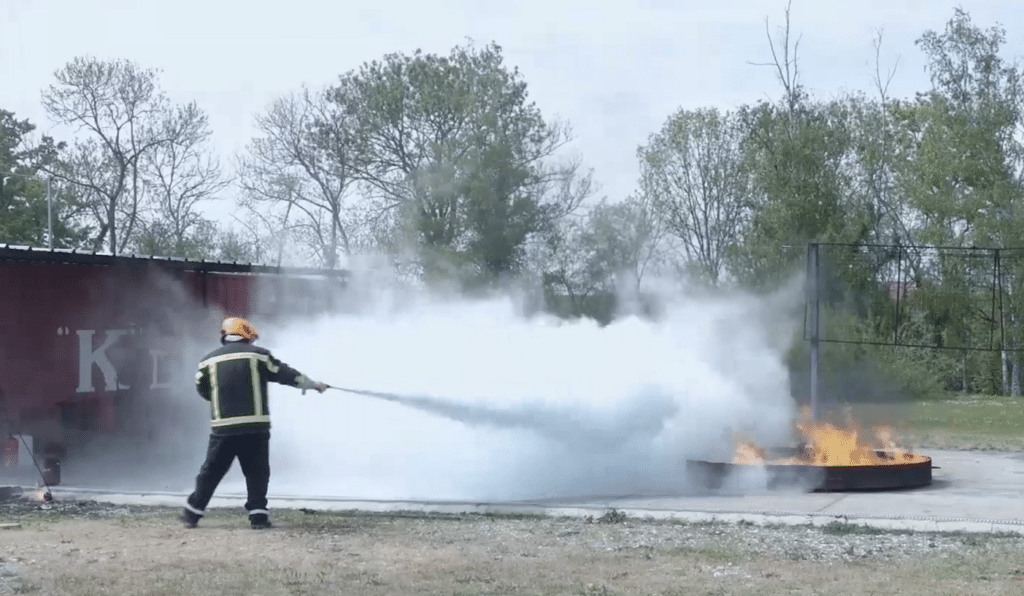Is PPE training mandatory?
The question of compulsory PPE (First Response Equipment) training is often raised. Is this training, which provides invaluable fire risk management skills, a legal necessity for companies? Understanding an employer's fire training obligations is crucial. It is also important to know who can provide this training, and how often it needs to be renewed.
Understanding EPI training
What is EPI training?
The role of the first response team member
First Response Teams (FRTs) play an essential role in emergency management, particularly in the event of fire. Their main task is to act quickly at the first signs of a fire to limit its spread and protect those present. Trained in the use of safety equipment such as fire extinguishers and fire hose reels (FHRs), the EPI intervenes before professional help arrives. They are also familiar with evacuation procedures, and are able to guide occupants to emergency exits in complete safety. In short, the first response team member is a key link in risk prevention and the protection of people and property.
EPI training: for whom?
First Responder training is aimed at anyone working in an environment where fire safety is a priority. It mainly concerns employees of companies, whatever their sector of activity, who are designated to intervene on the front line in the event of a fire. This training is particularly recommended for employees working in high-risk areas (factories, warehouses, buildings open to the public, etc.), but also in offices, where prevention is just as important. Safety officers, members of health and safety committees, and site managers are also encouraged to take this course, so that they are prepared to act effectively from the very first minutes of a disaster.
PPE training regulations
Employers' PPE training obligations
Employers are legally responsible for fire safety, including training employees in risk management. Under the French Labor Code (article R.4227-39), it is mandatory for employers to ensure that staff are trained in the use of first-response equipment, such as fire extinguishers, and in evacuation procedures.
The importance of PPE training in fire prevention
Fire risk prevention in the workplace
Preventing fire hazards in the workplace is a crucial priority to ensure the safety of employees and property. First Response Teams (FRTs) play a key role in this process. Their mission is not only to intervene rapidly in the event of fire, but also to prevent risks by adopting safe behaviors and raising awareness among their colleagues.
Prevention starts with identifying potential hazards: sources of heat, flammable products or faulty electrical equipment. IPEs, trained to recognize these risks, ensure that safety instructions are followed on a daily basis. They are also responsible for regularly checking the condition of fire safety equipment, such as fire extinguishers and alarm systems.
The role of PPE in the event of fire
Their role begins with detecting the fire, assessing the situation and taking appropriate action. They need to know how to use first-response equipment such as fire extinguishers and hose reels to extinguish or contain an incipient fire.
At the same time, the PPE is also responsible for ensuring the safety of occupants by applying evacuation procedures. He or she must guide employees or visitors to the emergency exits, while ensuring that no one remains in high-risk areas. The PPE coordinates the evacuation and communicates with the other parties involved to ensure that everyone is safe.
Finally, EPI informs the emergency services as soon as they arrive, providing them with valuable information about the fire (location, origin, flammable products present) to facilitate their response. Thanks to its rapid, effective intervention, PPE helps to reduce material damage and save lives.
Is PPE training mandatory for all employees?
Who needs PPE training?
-
Employees in high-risk businesses: In sectors where the risk of fire is higher (factories, warehouses, industrial sites, establishments open to the public), it is essential that several members of staff are trained to react immediately.
-
Employer-designated employees: The French Labor Code requires employers to designate and train certain employees to ensure fire safety. These are often employees who have volunteered or been designated to ensure day-to-day safety.
-
Members of the internal safety department: In some companies, particularly large ones, dedicated safety teams are set up. These members are required to undergo PPE training in order to intervene effectively in the event of an incident.
-
Anyone involved in risk prevention: members of health, safety and working conditions committees (CHSCT), maintenance managers and building managers can also benefit from this training, to improve their fire prevention skills.
Second intervention team members and PPE training
Definition and role of ESI in the company
The Second Response Team (SRT) is an employee trained to intervene in addition to the First Response Team (FRT) when a fire or emergency situation exceeds the initial response capabilities. Often a member of a company's fire safety team, ESIs have more advanced training than PPEs, including the use of specialized equipment and more advanced intervention techniques.
ESI's role :
-
Reinforcing the response: After the IPEs have intervened, the IMTs take over if the situation is more serious or requires the use of more sophisticated means. They generally take action before the fire department arrives, in an attempt to contain the fire and limit its spread.
-
Use of specialized equipment: Unlike PPE, IMTs are trained to use more complex equipment, such as fire hoses, smoke extraction systems and specific personal protective equipment.
-
Collaboration with emergency services: ESIs are also trained to work in coordination with the fire department or other emergency services. They provide crucial information on the fire (location, type of fire, associated risks) and assist the emergency services on site.
-
Risk management in the event of a major disaster: ESI is particularly important in high-risk businesses, such as industrial sites, where large-scale disasters can occur. Their rapid, effective response helps reduce damage and protect human lives.
Is ESI training compulsory?
Second Response Team (SRT) training is not legally mandatory for all companies, unlike certain fire safety training courses such as First Response Team (FRT) training. However, it is strongly recommended for companies with high fire risks or specific activities, such as industries, warehouses, SEVESO sites, or any other establishment where serious fires could occur.
How long is PPE training valid?
Validity of PPE training
First Responder training has no legally-defined validity period, but regular refresher courses are strongly recommended to ensure that employees' skills remain up-to-date and effective.
Validity recommendations :
-
Annual refresher training: Although not required by regulations, it is generally advisable to carry out refresher training every year, or every two years. Refresher training allows you to review acquired knowledge, update skills and practice the use of new equipment or procedures.
-
Adapting to risk: In certain companies where the risk of fire is higher (industries, complex buildings), we recommend shortening this interval and organizing more frequent refresher sessions, to maintain an optimum level of vigilance and competence.
-
Regular practical exercises: In addition to theoretical refresher courses, evacuation drills and fire simulations are often organized several times a year to ensure that all PPE is ready for effective intervention.
In summary, although there is no fixed period of validity, the general recommendation is to update PPE training at least every 1-2 years to ensure the team's effectiveness in the event of a fire.
Is refresher PPE training mandatory?
French legislation does not explicitly require refresher training for First Response Teams. However, it is strongly recommended and considered good practice in fire safety.
Why is recycling recommended?
-
Updating knowledge: Initial training covers the basics of fire prevention and management, but refresher courses update PPE knowledge to take account of regulatory changes, new equipment and prevention techniques.
-
Maintaining skills: Retraining helps keep PPE skills at a high level. By repeating procedures and practicing regularly, employees remain efficient and responsive in the event of an incident.
-
Adapting to change: Working conditions and risks can change, and so can fire safety equipment. Retraining ensures that PPE is well informed about new procedures and any changes in equipment or safety standards.
-
Compliance with internal standards: Some companies, particularly those with stringent safety policies or specific requirements, may impose regular retraining to comply with their own safety standards.
Although legislation does not make retraining compulsory, best practice recommends that it should be carried out every 1-2 years to ensure that First Response Teams remain well prepared to deal effectively with emergency situations.
Conclusion: the importance of PPE and ESI training in risk prevention
The training of First Response Teams (FRT) and Second Response Teams (FRT) plays a crucial role in risk prevention and emergency management within companies. Such training not only meets a legal requirement, it is essential to guarantee employee safety and protect assets against fire and other hazards.
Thanks to their training, First Response Teams (FRTs) are able to quickly detect signs of fire, use basic equipment to limit damage, and coordinate evacuations. Their rapid intervention can not only limit the extent of damage, but also save lives. Regular updating of their skills, through refresher courses, ensures their ongoing preparedness for any incident.
Second Response Teams (SRTs) intervene when the situation becomes more complex or requires more sophisticated resources. Their role is crucial in high-risk environments, where their expertise enables emergency situations to be managed effectively before the arrival of professional rescue services.
In short, PPE and ESI training is more than just an obligation: it's a strategic investment in improving overall company safety. It helps create a safer working environment, reduces the risk of major incidents, and ensures an appropriate response in the event of an emergency. By training PPE and ESI correctly and regularly, companies demonstrate their commitment to the safety of their employees and the preservation of their assets, while complying with best practice in risk prevention.



